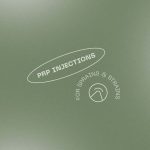Blog
PRP Injections for Sprains & Strains

Overview of PRP Therapy
PRP stands for platelet rich plasma – platelets and plasma are natural components of the blood. Platelet rich plasma contains a significantly higher than normal amount of platelets and regenerative substances, such as platelet growth factors, that support all phases of wound healing and tissue repair.
PRP therapy is a type of therapy done by injection that extracts plasma from your own blood to isolate platelets. This isolated, platelet rich plasma is then infused back into the body within the affected area to stimulate the healing process.
PRP therapy is especially indicated for parts of the body that receive low blood flow, such as ligaments and tendons, and that therefore are slow to heal. With chronic injuries, such as recurrent ankle sprains, low-grade inflammation can persist for years without completely healing.
The process at LIVV is simple – first, you consult with one of our amazing naturopathic doctors to make sure PRP therapy is right for you. Second, you come in for the quick procedure that entails 3 small injections (1. numbing, 2. removal of blood, 3. putting in PRP).
Typically, 3-5 treatments are needed within a few weeks for full therapeutic benefit. The number and frequency of sessions will depend on your condition and severity. Your ND will also provide additional recommendations to support recovery.
Improvements in pain, structure, and function are usually seen in just 1-2 weeks after treatment – with even greater improvement experienced with progressive treatments! Overall, this therapy is popular because of its speed, safety, and effectiveness.
For more info on PRP – read our blog on PRP Joint Injection Therapy!
The Difference Between Sprains & Strains
A sprain is defined as an overstretch or tear of ligaments – ligaments are tough bands of fibrous tissue that connect bones inside of joints. A strain is defined as an overstretch or tear of muscles and/or tendons – tendons are fibrous cords of tissue that connect muscle to bone.
Sprains can be caused by anything that forces a joint beyond its normal limit, such as falling on an outstretched arm, landing with impact on the ankle, over-twisting the knee, or a direct blow to the body. Common sprains include those of the ankle, knee (ACL, MCL, LCL), wrist, and shoulder.
Strains can be caused by anything that forces a muscle/tendon beyond its normal limit, such excessive twisting or pulling in sports of contact (e.g. soccer), extensive gripping (e.g. gymnastics), or throwing (e.g. baseball). Common strains include those to the back, hamstrings, quadriceps, forearms, elbows, and biceps.
Symptoms of both sprains and strains include pain, swelling, limited range of motion, instability, and possible loss of function. Symptoms specific to a strain include muscle spasms, weakness, and cramping.
Sprains and strains can occur in different areas in the body that are held together by either ligaments or tendons, respectively. The severity depends on the number of ligaments or muscles/tendons involved and whether a tear is partial or complete.
Severity is classified by grades:
- Grade I (mild; overstretch or slight tear)
- Grade II (moderate; partial tear)
- Grade III (severe; complete tear). Acute conditions are due to recent trauma or injury and chronic conditions are due to overuse (prolonged, repetitive movements)
Tendons and ligaments are very strong tissues whose primary function is to hold muscles and bones together – this activity does not rely on direct blood flow, so these tissues lack blood vessels. Muscles are soft tissue whose primary function is to move body parts – contraction relies on direct blood flow, so these tissues are full of blood vessels.
The poor blood supply in tendons and ligaments causes them to heal slower than muscle tissue. However, they do receive indirect nourishment from the blood in the form of a fluid that bathes them and keeps them healthy.
PRP Therapy for Sprains & Strains
When it comes to healing, proper rest and good nutrition are essential. The body needs both the time to regain function and the raw materials to rebuild damaged tissues. Using the compromised body part before it’s ready and/or eating a Standard American Diet can exacerbate the injury and prolong the healing process.
When we rest and eat healthy, adequate blood flow can be received by the tissues that need it and the right ingredients for restoration can be provided. Since increased blood flow helps tissues heal, anything that increases blood flow will aid the healing process, such as applying heat/cold, gentle movement, and massage.
These are the foundations of healing, but an obstacle to cure in the case sprains and strains is the lack of blood flow to the site of injury. If only there were a way to supply these tissues with exactly what they need to heal… PRP therapy is an incredible solution.
PRP provides that direct supply of healing factors at a greater extent than would occur normally to the tissues. It allows for your own blood components to heal the injured ligaments and tendons more entirely and at a faster rate than naturally possible.
With this extra support, the time it takes for these tissues to get back to normal, that might otherwise take weeks or months, is significantly accelerated. This is particularly important for athletes, allowing them to return to their sport as soon as possible after injury while reducing the risk of re-injury and alleviating symptoms of pain and inflammation.
However, this therapy will help anyone with these types of injuries that interfere with daily living or cause consistent discomfort. In addition to ligaments and tendons, PRP therapy treats inside and outside of the joint capsule to reach fascia, collagen, and cartilage.
PRP therapy for sprains and strains is a great way to optimize performance with minimal invasiveness. Always consult your health practitioner about managing and treating physical injuries. Call us today to schedule your consultation for PRP therapy!
Written by Jordan Valdez
Resources
https://www.niams.nih.gov/health-topics/sprains-and-strains


